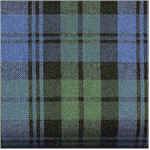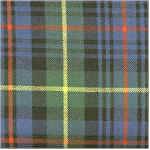|
|
Tartan in Scotland |
 |
|
|
Tartan in Scotland |
 |
Tartans - a brief guide - how they came about, how they are made. They are a lot more "modern" than you might think.
What is it
Originating in Scotland, it is a plaid that was unique to a
particular clan. Originally "tartan" designated how the
woollen
thread was woven into cloth. Each individual thread went over two threads then
under two threads, and so on..This means that there is always a square
where two colours cross, giving that speckled effect.
The Gaelic word for it is Breacan, meaning partially colored
or speckled, and every one today features a multi-colored
arrangement of stripes and checks. These patterns, or Sett's, are used to identify
the Clan, Family or Regiment with which the wearer is associated.
Strangely enough clan patterns were not something that have evolved out of the mists of time in Scotland. The first documented reference dates from 1703.
Earlier examples do exist - for example a two colour check pattern cloth was found near the Roman Anonine Wall, dating from around 300 AD. But it is a long way from what we know as a plaid today.
It is now generally recognised that clan plaids were established in the late 18th century. Before that individual patterns had existed, but not the concept of a distinctive clan pattern

History cloth in Scotland
Although individuals may well have worn tartan earlier, the
first attempt at a clan pattern was in 1618, when Sir Gordon of Gordonstoun
wrote requesting that the plaids worn by his men were in "harmony with
that of his other Septs."
It was probably only after the Act of Union in 1707, that tartan became a symbol
of active nationalism. Both highlanders and lowlanders, opposed to the Act,
spread the wearing of it. It was seen by the government as the
"uniform of rebels".
After the 1715 Jacobite rising, the Government felt the need to take more control in the Scottish Highlands. A number of independent companies were formed, who became known as the Black Watch because the cloth they wore was very dark. By 1740 these various groups were merged into a regiment, and a new Black Watch pattern was developed especially for them, so that they were not associated with a particular clan. This is the first to have a documented pedigree
Following the battle of Culloden, there was a complete ban on Highland dress from 1746 until its repeal in 1782. Newly formed Highland Societies in London and Edinburgh then made great efforts to restore the Scottish Highland culture.
And indeed the Scottish Highland regiments in the British army exploited the aura of the warlike highlander in his kilt. Although tartan was banned by law, the Government or Black Watch pattern was the only legally one. Therefore Black Watch was used as the basis for other Scottish regiments
Up until this point in time, the highlander had worn not a kilt, but a belted plaid. This was a one-piece six-yard long cloth, belted about the waist with the remainder being worn thrown over the shoulder. A new kilt was developed, probably by city tailors. It as the traditional plaid with the pleats permanently sewn in.
In 1822, by the time of the first Royal visit to Scotland since the Jacobite rebellion, there were around 200 different patterns on record. George IV himself wore the newly fashionable kilt on this visit. Today that number has risen to over 2,000 registered patterns representing not just clans but also countries, corporations and events.Commercialism appears to have taken hold of the plaid
There is much evidence that most of the recognizable patterns seen today are in fact creations of Scottish and English Tailors during the reign of Queen Victoria(1831-1901).
Today the wearing of the kilt has become once again associated with Scottish Nationalism, with its wearing making a statement of nationality. It is perhaps surprising that today's traditions centred on the kilt were developed in the 19th century by the English and Scottish gentry, not the Scottish Highlanders.

Different types


| Scotland Calling Scotland Calling Front Page |
|
| . | |
| Good hotels in Scotland Good Hotels in Scotland |
|